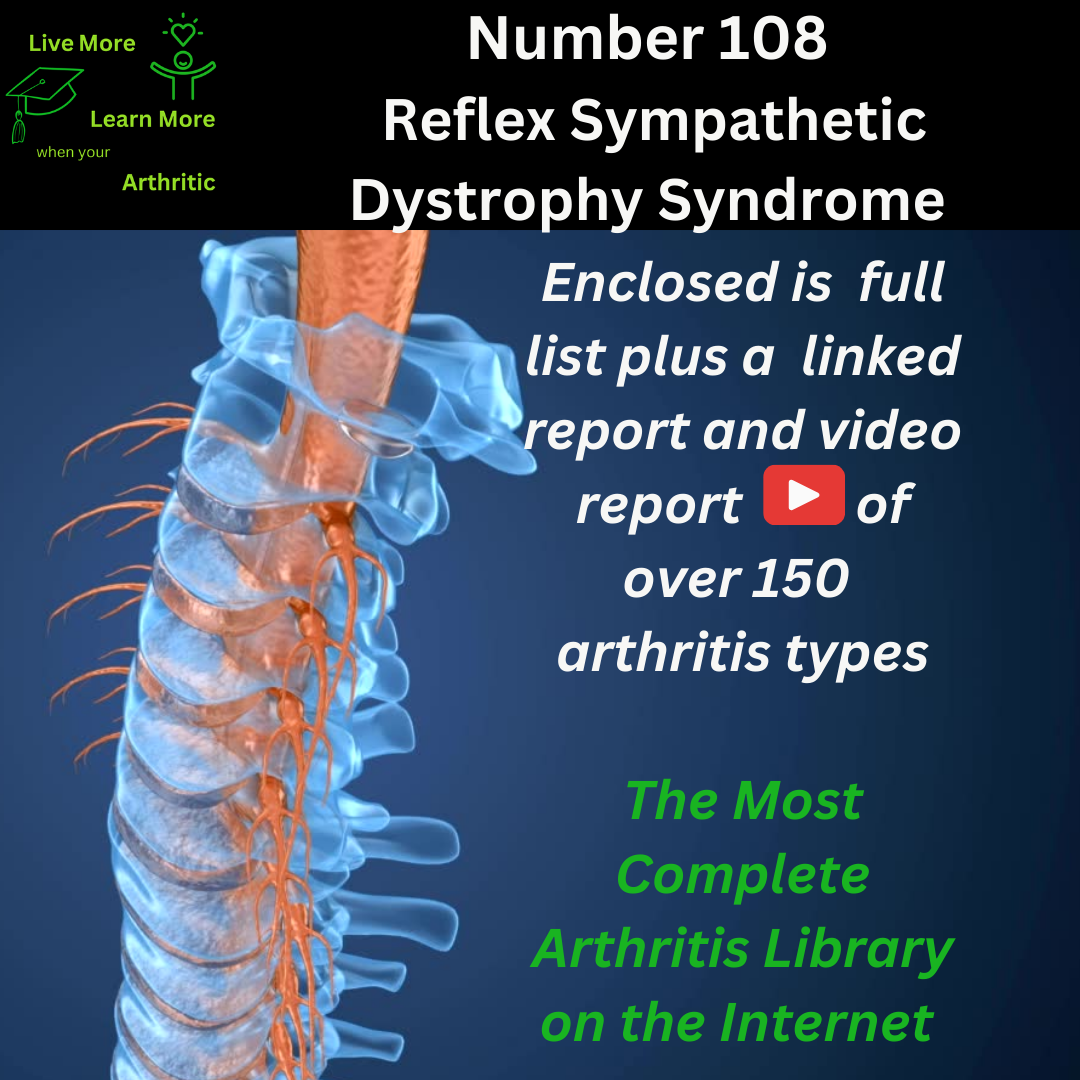
Reflex Sympathetic Dystrophy Syndrome: Number 108 of around 150 types of Arthritis
Unveiling Reflex Sympathetic Dystrophy Syndrome: Navigating a Complex Condition
Reflex Sympathetic Dystrophy Syndrome (RSDS), also known as Complex Regional Pain Syndrome (CRPS), is a mysterious and often misunderstood disorder that wreaks havoc on the body’s nervous system. Let’s dive into the details of this enigmatic syndrome, starting with its impact on the body.
 Areas Affected: From Limbs to Beyond
Areas Affected: From Limbs to Beyond
RSDS primarily affects the limbs, particularly arms, legs, hands, and feet. It’s characterized by intense, burning pain that can spread, affecting larger areas over time. The skin in these regions may become swollen, discolored, and excessively sensitive.
Remission and Resilience: Chasing Hope
Achieving remission with RSDS can be challenging, but it’s not impossible. Early intervention and comprehensive treatment plans that include physical therapy, pain management, and psychological support can significantly improve outcomes.
Decoding the Syndrome: Triggers and Tale
The exact causes of RSDS remain elusive, but it often develops following trauma or injury to a limb. This could be a fracture, surgery, or even a minor sprain. The nervous system goes haywire, sending abnormal signals of pain and inflammation.
Symptoms: A Symphony of Sensations
Symptoms of RSDS go beyond pain. They encompass changes in skin temperature and texture, excessive sweating, and limited range of motion due to joint stiffness. The affected limb may also appear swollen or show signs of muscle wasting (atrophy).
Onset and Occurrences: The Uninvited Guest
RSDS can strike at any age, but it’s more common between 40 and 60 years old. Interestingly, women are three times more likely to be affected than men, though the reason behind this gender discrepancy remains a medical mystery.
Arthritis or Allies: Unraveling the Connections
RSDS isn’t classified as a form of arthritis, but its impact on joints and surrounding tissues can mimic arthritis-like symptoms. The pain and stiffness associated with RSDS can lead to secondary joint issues if left untreated.
Risk Factors: Beyond the Ordinary
Risk factors for RSDS include previous limb trauma or surgery, as well as certain genetic predispositions. Those with other chronic pain conditions or autoimmune disorders may be more susceptible to developing RSDS.
Complications: Navigating the Unknown
Complications of RSDS extend beyond physical discomfort. Psychological distress, including anxiety and depression, is common due to the chronic and debilitating nature of the syndrome. Social isolation can also occur.
Inflammation and Inquiries: The Swelling Saga
Inflammation is indeed a factor in RSDS, driven by dysfunctional signaling within the nervous system. The body’s response to perceived injury or trauma becomes exaggerated, leading to ongoing inflammation and swelling.
Tenderness and Tangles: The Joint Journey
Joint tenderness in RSDS is a consequence of nerve hyperactivity. The brain misinterprets signals, perceiving normal touch as painful. This hypersensitivity contributes to the limited range of motion often experienced.
Range of Motion: A Slow Retreat
Loss of range of motion in RSDS stems from a combination of pain, stiffness, and muscle atrophy. Without timely intervention, joints can become increasingly immobile, further complicating daily activities.
Empowering Resilience: Pursuing Quality of Life
A proactive approach to managing RSDS is essential for enhancing quality of life. This includes a multidisciplinary treatment plan involving physical therapy, occupational therapy, and psychological support. Learning coping strategies and staying engaged in activities can also boost resilience.
Complications Explored: Navigating the Minefield
Complications of RSDS are multifaceted, encompassing psychological distress, muscle wasting, and increased susceptibility to infections due to compromised immune function. Chronic pain can also lead to sleep disturbances and fatigue.
 Demographics Discovered: The Faces of Affliction
Demographics Discovered: The Faces of Affliction
RSDS often strikes during middle age, but cases in younger individuals are not uncommon. Women are disproportionately affected, possibly due to hormonal influences on pain perception.
Interconnected Insights: Unveiling the Links
RSDS shares similarities with other chronic pain syndromes and autoimmune disorders, suggesting potential interconnected pathways within the body’s immune and nervous systems. Awareness of these associations is crucial for comprehensive disease management.
In conclusion, navigating Reflex Sympathetic Dystrophy Syndrome requires a blend of medical expertise, emotional support, and resilience. By embracing proactive strategies and understanding the multifaceted nature of RSDS, individuals affected by this syndrome can forge a path toward a more empowered and fulfilling life.

